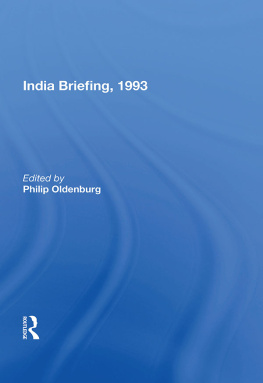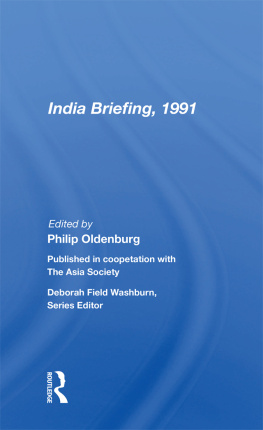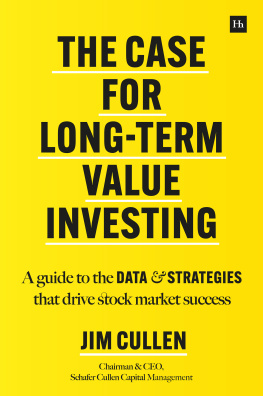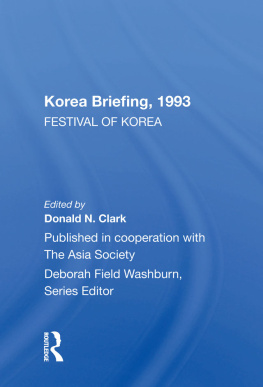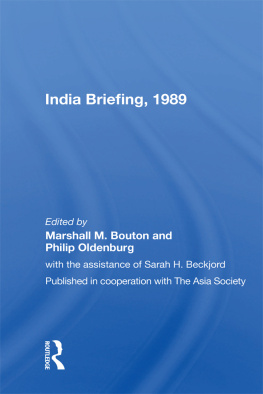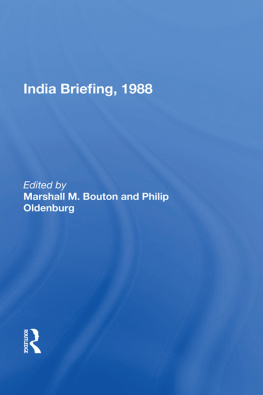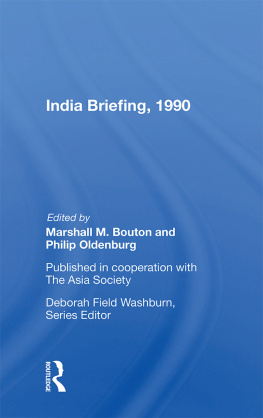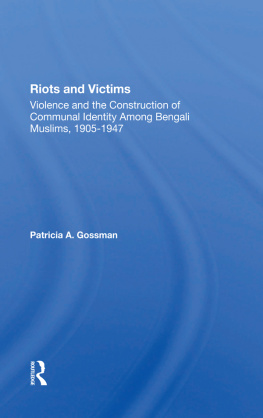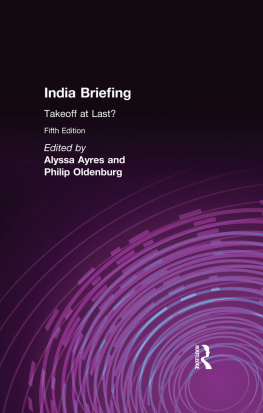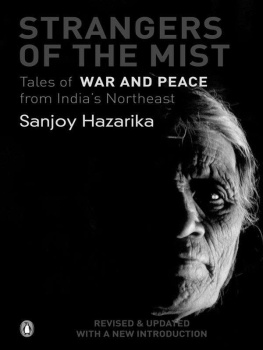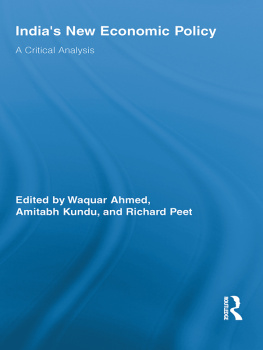First published 1993 by Westview Press
Published 2018 by Routledge
52 Vanderbilt Avenue, New York, NY 10017
2 Park Square, Milton Park, Abingdon, Oxon OX14 4RN
Routledge is an imprint of the Taylor & Francis Group, an informa business
Copyright 1993 by The Asia Society
All rights reserved. No part of this book may be reprinted or reproduced or utilised in any form or by any electronic, mechanical, or other means, now known or hereafter invented, including photocopying and recording, or in any information storage or retrieval system, without permission in writing from the publishers.
Notice:
Product or corporate names may be trademarks or registered trademarks, and are used only for identification and explanation without intent to infringe.
Library of Congress ISSN: 0894-5136
ISBN 13: 978-0-367-01198-7 (hbk)
India Briefing, 1993 is the seventh in a series of annual reviews of major events, issues, and trends in Indian affairs. Previous volumes have reported on devastating droughts followed by economic recovery, separatist challenges followed by harsh central response, domestic protests and governmental collapse followed by orderly democratic transition. A common theme has been Indias resilience in the face of turmoil and tragedy. This years volume demonstrates that India is under greater stress than ever before.
At the close of 1992, the secular foundations of the Indian state were shaken by a cataclysmic event, the storming and destruction by Hindu extremists of the Babri mosque in Ayodhya, a town in Uttar Pradesh. The culmination of eight years of agitation for the liberation of the site and the construction there of a Hindu temple, this act of violence brought to a head the ideological (secular versus Hindu nationalist) and communal (Hindu versus Muslim) tensions that have continued to wrench India since partition in 1948. It also weakened the government of P. V. Narasimha Rao and may have hastened the decline of the ruling Congress Party. In the lead chapter of India Briefing, 1993, Ashutosh Varshney puts the eruption in Ayodhya into long-term perspective, showing its connection to the ongoing question of Indian national identity.
Other chapters in the volume deal with Indias foreign policy and its economic reforms, which were disrupted but not derailed by the events at Ayodhya. Paul Kreisberg points to a positive thrust in Indias relations with the outside world, despite the situation in troubled Kashmir and its deleterious effect on India-Pakistan relations. Particularly noteworthy are increased cooperation between India and China on a range of issues, including border negotiations, and Indian efforts to improve economic relations with the countries of East and Southeast Asia, the European Community, and the United States. The success of Indias foreign policy depends on its domestic political stability and a continuation of economic liberalization.
Jay Dehejia takes up the subject of the economic reforms, arguing that though the pace of reform has been slow, the momentum is increasing, with a positive effect on the economy. Neither the Bombay stock market scandal of 1992 nor the riots and bombings of early 1993 have stanched the trickle of foreign investment into India, and Dehejia believes that as trade liberalization and other reforms take hold, investment will increase. By February 1993 India had lowered its inflation rate to 6.9 percent from a high point of 17 percent in August 1991 and reduced its budget deficit to 5 percent of GDP. As a result of these promising signs, donor countries have pledged a record $7.2 billion in aid.
The ultimate goal of economic reform is to eradicate poverty and produce a better quality of life for Indias 885 million people. In his discussion of the Indian Constitution, Granville Austin demonstrates that the rule of law in India has worked to improve the lot of minorities and underprivileged social groups, up to a point. (The rights of religious minorities are constitutionally protected, but this has led to complications. Though the failure of the legal system to prevent the destruction of the Babri mosque is, in Austins view, an extreme example, it points to the basic incompatibility between religious and civil law.) Civil liberties, the Fundamental Rights granted by the Indian Constitution, need to be protected and access to the judicial system improved. These causes are increasingly being taken up by nongovernmental social action groups.
Democracy is exercised not only in the courts but at the grass roots. Smitu Kothari chronicles the growth of citizen-based groups fighting for social and economic justice. He presents as an illustrative case the controversy over the Sardar Sarovar dam on the Narmada Rivera struggle that pits state and central government efforts at large-scale economic development against the subsistence economies of local indigenous groups. Like other chapters in this volume, Kotharis discussion addresses major domestic and global questions of governance and responsibility.
As do previous volumes, India Briefing, 1993 includes a chapter on culture, this years topic being cinema and television. Pradip Krishen gives an illuminating account of the roots of contemporary popular culture in the theatrical traditions of the 19th and early 20th centuries. He goes on to discuss state-controlled television; here too, the emphasis is on the challenges that confront the government of India as it walks a fine line between subscribing to democratic values and maintaining its authority.
Every year our authors and editors express the fervent hopeor, in some cases, the convictionthat India will once again transcend the years crises and turbulence. The events of late 1992 and early 1993 constitute a critical test of Indias extraordinary resilience. India is grappling with unprecedented change in all aspects of its national life. India Briefing, 1993 aims to increase readers understanding of this vibrant evolutionary process.
The India Briefing series is prepared by the Contemporary Affairs Department of The Asia Society and copublished with Westview Press. The Societys Center for India-U.S. Education, with major funding from the Hinduja Foundation, sponsors the series to further its goal of supporting public education on India. We wish to thank the Hinduja Foundation for its generosity.
Thanks are also due to editor Philip Oldenburg and his superb team of authors, and to Susan McEachern and her dedicated staff at Westview Press. At The Asia Society, Senior Editor Deborah Field Washburn oversaw the project from start to finish. She was assisted by Sayu Bhojwani, who played a significant role in editing the chapters, in addition to managing communications with authors. Shyama Venkateswar compiled the chronology, bringing to it her substantial knowledge of India. Patricia Farr copyedited the manuscript with skill and sensitivity. Maria Tham made numerous helpful suggestions, and Lisa Park proofread and assisted in the final stages of editorial production. This volume is the result of the best efforts of all these individuals.
Marshall M. Bouton
Executive Vice President
The Asia Society
June 1993



